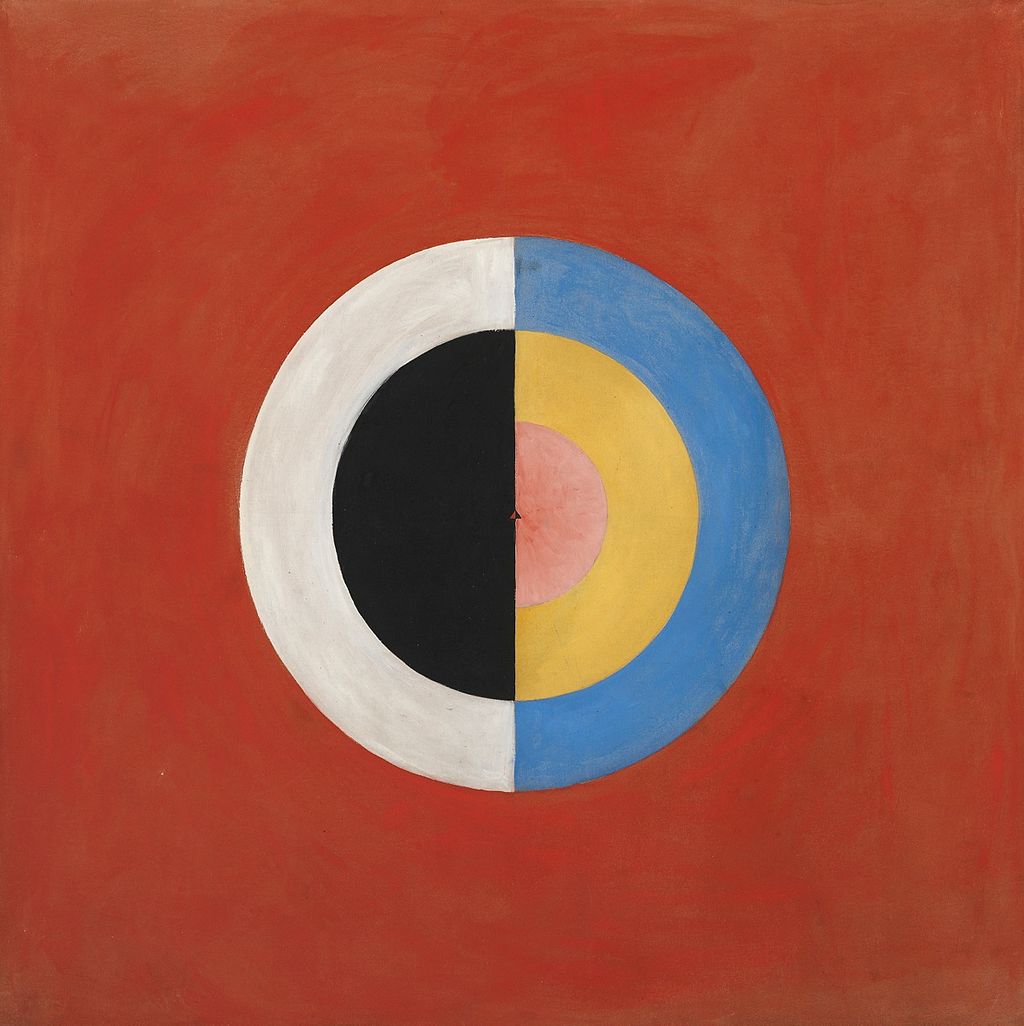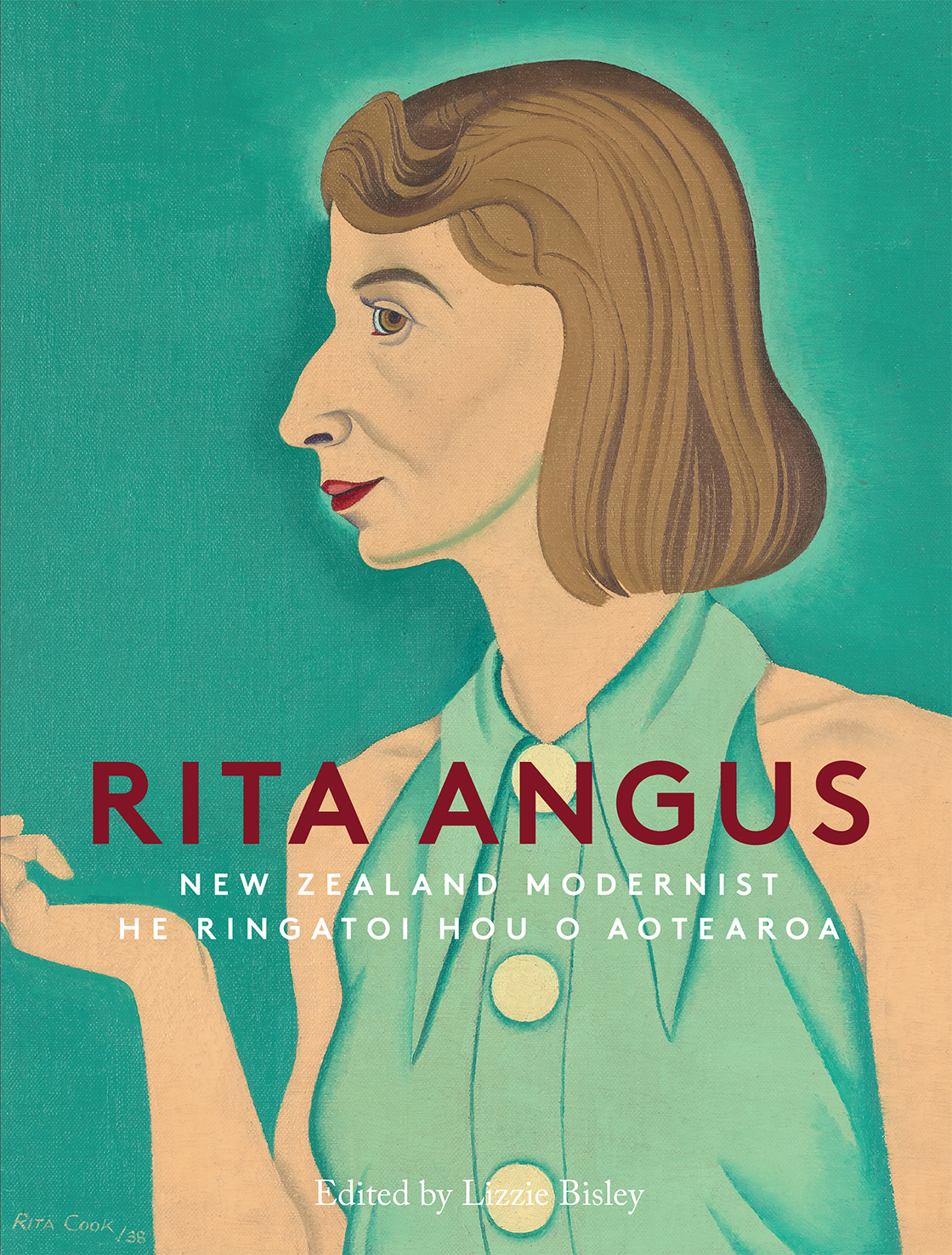
Two major exhibitions by female artists currently on view in Wellington could not be more exciting or different. Hilma af Klint’s large, abstract, and light-filled geometric compositions contrast sharply with Rita Angus’ small, but densely layered portraits and landscapes. The fact that both artists were pioneering feminists may account for much of their current popularity, but the real test lies in the art they produced, rather than their political, spiritual, or social opinions.
City Gallery’s current exhibition, entitled Hilma af Klint: The Secret Paintings, clearly demonstrates that she is one of the most sublime and neglected artists of the twentieth-century. Whether Angus can also hold her own on the international stage or will simply be reduced to the status of a curious social observer and short story writer like Katherine Mansfield, her parochial appeal will undoubtedly remain undiminished.
Af Klint (1862-1944) was a Swedish artist and mystic whose paintings are among the first abstract works in Western art history, predating much better known compositions by Wassily Kandinsky and Piet Mondrian. Her work can best be understood in the wider context of the Modernist search for new forms in artistic and scientific systems at the turn of the century. Many artists shared these concerns during the same period, including not only Kandinksy and Mondrian, but also Kasimir Malevich, and the Nabis Group of artists surrounding Maurice Denis, all of whom were similarly inspired by the obscurantist musings of Madame Blavatsky. Af Klint, however, felt her work was so revolutionary that the world was not yet ready for it and wanted her paintings to remain unseen for twenty years after her death.
While a student at the Swedish Royal Academy of Fine Arts she met Anna Cassel, one of four women with whom she later worked in ‘De Fem’ (‘The Five’), a group of artists who shared her ideas and began their association as members of the Edelweiss Society, which embraced a combination of the Theosophical teachings and spiritualism. They were fascinated by the paranormal and regularly organised séances, opening each meeting with a prayer, followed by a meditation, a Christian sermon, and a review and analysis of a text from the New Testament. They recorded a complex system of mystical thought in the form of messages from higher spirits they called ‘The High Masters,’ one of whom enigmatically announced, "All the knowledge that is not of the senses, not of the intellect, not of the heart, but is the property that exclusively belongs to the deepest aspect of your being [is] the knowledge of your spirit.”
Af Klint's initial interest in abstraction and symbolism came from her involvement in this fashionable form of spiritism which lead to an interest in Theosophy and the philosophy of Christian Rosencreutz as early as 1879. In 1908 she met the founder of the Anthroposophical Society, Rudolf Steiner, who was visiting Stockholm. Twelve years later she visited the Goetheanum in Dornach, Switzerland, and spent long periods there from 1921-30, where Steiner introduced her to his artistic theories and deeply influenced her approach to painting. Esoteric spirituality remained the core source of her creativity throughout the rest of her life.
In one of her few remaining letters, she asked Steiner to visit her in Stockholm and see the finished part of ‘The Paintings for the Temple’ series, one hundred and eleven in total. Steiner was left unimpressed, stating that her way of working was inappropriate for a theosophist (according to Blavatsky, mediumship was a faulty practice, leading its adepts on the wrong path of occultism and black magic). Steiner also insisted that their contemporaries would have a hard time accepting her paintings and it would take another fifty years for the uninitiated to decipher them. Steiner paid special attention to ‘The Primordial Chaos Group,’ considering them to be "the best symbolically.”
Af Klint was devastated by Steiner’s response and stopped painting for four years, but he retained a number of photographs of her artworks, some of them hand-coloured. Later the same year he met Kandinsky, who had not yet started painting his abstract canvases, and some art historians have suggested that Kandinsky may have seen the photographs and been influenced by them.
Af Klint had started experimenting with automatic drawings as early as 1896, leading her toward an inventive geometric visual language she felt was capable of conceptualising invisible forces at play in both the inner and outer worlds. She explored world religions, atoms, and the plant world, and wrote extensively about her discoveries. As she became more familiar with this form of expression, she was assigned by ‘The High Masters’ to create ‘The Temple’ series of paintings, even though by her own admission she never understood precisely what this referred to.
After twenty years of artistic endeavour, at the age of forty-four, af Klint produced her first series of abstract paintings. This later period of abstract art delved into symbolism with a combination of geometry, figuration, scientific research, and religious practice. Her studies of organic growth, including shells and flowers, helped her portray life through a spiritual lens, while her idiosyncratic style was influenced by late nineteenth and early twentieth century scientific discoveries.
The works for ‘The Temple’ were painted between 1906 and 1915 in two major phases, with a four-year gap from 1908-12. The collection consists of one hundred and ninety-three paintings, grouped within several sub-series. The major paintings, dated 1907, are extremely large, each measuring approximately 240 x 320 cm. This series, called ‘The Ten Largest,’ describes the different phases of life, from early childhood to old age.
As af Klint explored this new form of visual expression, her paintings became both more autonomous and intentional. Quite apart from their diagrammatic purpose, they retain a freshness and a modern aesthetic of tentative line and hastily captured image - a segmented circle, a helix bisected and divided into a spectrum of lightly painted colours. Her artistic world is impregnated with symbols, letters, and words, producing paintings that often depict symmetrical dualities, polarities, and reciprocities - up and down, in and out, earthly and esoteric, male and female, good and evil, etc.
Af Klint's symbolic visual language has an ordered progression that reflects her deep understanding of grids, circles, and petal-like form - sometimes distinctly formal and diagrammatic, sometimes biomorphic and reminiscent of Joan Miro. Her paintings also explored the physical/spiritual dichotomy of the world, with spiral forms in particular appearing often in her art, as they did in De Fem’s automatic drawings. Spirals employ the Fibonacci sequence to suggest growth, progress, and evolution, while her colour choices also are clearly metaphorical attempts to represent the sublime in art. Colour for af Klint was always metaphorical proposition - blue representing the female spirit, yellow the male, and pink/red physical and spiritual love. The Swan and The Dove are similarly symbolic, representing transcendence and love respectively. Understood as portal to other dimensions, her paintings demand to be interpreted on narrative, esoteric, and artistic levels, while also evoking primordial geometric and humanistic motifs.
Af Klint felt she was being directed by a force that literally guided her hand - “The pictures were painted directly through me, without any preliminary drawings, and with great force. I had no idea what the paintings were supposed to depict; nevertheless I worked swiftly and surely, without changing a single brush stroke.” After completing the works for ‘The Temple,’ the spiritual guidance apparently ended. However, af Klint continued to pursue abstract painting, now independent from any external influence. Both transcendence of the physical world and the constraints of representational art remained a constant fixation.
While the paintings for ‘The Temple’ were mostly done in oils, af Klint was also (like Angus) a highly skilled water colourist. Her later paintings are significantly smaller, including a series depicting different religions at various stages in history, as well as representations of the duality between the physical being and its equivalence on an esoteric level. Throughout her life, she sought to explain the mysteries she had come in contact with through her work, producing over one hundred and fifty notebooks, filled with philosophical musings, rough sketches, and more developed studies. Later in life, af Klint made a decision to destroy all her correspondence, leaving a collection of more than 1,200 paintings and 125 diaries to her nephew. Among her last paintings are two extraordinary water colours predicting the events of WWII, titled The Blitz and The Fight in the Mediterranean.
Af Klint’s canvases were first revealed to the public at the exhibition ‘The Spiritual in Art, Abstract Painting 1890 - 1985,’ organised by Maurice Tuchman in Los Angeles in 1986. The subsequent Guggenheim Museum exhibition in New York (‘Hilma Af Klint: Paintings for the Future’) proved to be the most popular exhibition in the museum’s sixty-year history, attended by over 600,000 visitors. City Gallery has achieved a magnificent coup in presenting her visionary work to a New Zealand audience in these turbulent times.

I covered Jill Trevelyan’s excellent biography of Angus in an earlier issue of Scoop, but the current exhibition at Te Papa provides an excuse (if one were needed) to revisit her pictorial achievements. The current exhibition is certainly an improvement on its predecessor, where the impact was vitiated through the well-intended inclusion of too many indifferent works.
The new hang is spare, even austere - surely much as Angus would have wished. This enhances the compelling power of her finest paintings, successfully conveying the strength of her personality and the constancy of her vision. Much like af Klint’s sparse geometries and Frida Kahlo’s compelling infantilism, Angus’ faux-naivety disguised a sophistication that evolved into a mesh of highly personal symbols (including elliptically paired eyebrows and parabolic bird wings, eyes and hair, shells and fish, buildings and flowers) which recur throughout her work.
The flatness and vertically stacking of her landscapes were clearly influenced by Japanese print making and resolutely refuse any real sense of perspective, while the almost total absence of people suggest she was much more interested in conveying a vivid sense of pure form and colour (especially her somewhat unnerving obsession with orange and green).
In a personal appraisal, art historian Mark Stocker considers that “Among the three great NZ twentieth-century painters - McCahon, Walters, and Angus - the last is far and away the most attractive and accessible. While McCahon is dark and often weird, and Walters cerebral but limited, Angus paints what she sees in imagery that everyone can recognise and enjoy. Even if she is not the greatest oil painter, as a water colourist she is often quite breathtaking.”
“She was quite an 'easy' artist - only briefly abstract (before she realised how awful it was), but highly figurative and determinedly linear, with solid colours filling in the spaces surrounded by the outlines. An excellent draughtsman, she could have been a successful illustrator for Marvel Comics, but never became an oil painter of the first rank, unlike her near contemporary Rata Lovell-Smith, whose work has been insufficiently recognised."
"Her landscapes exploit the sharp, clear light that has captivated visitors, artists, and Kiwis for generations and depict a simple rural mythology with which we can all identify. Opinion will always be divided over the value of her portraiture (especially the self-portraits), partly because they reflect her misanthropic narcissism, but also because there is just too much of it. Many of her other portraits are intensely compelling, however, and Rutu is still an unforgettable image.”
Te Papa Press have produced a highly informative companion catalogue, edited by Lizzie Bisley, to accompany the exhibition, in which ten writers offer fresh perspectives on Angus. The current exhibition came about after a conversation between Adrian Locke and Te Papa’s Head of Art, Charlotte Davy, in 2018. Locke, who is curator at London’s Royal Academy, saw Cass at the Christchurch Art gallery and was eager to find out more about her work. He designed a major Angus show that was due to have opened at the Royal Academy in September 2020. Sadly, the global pandemic forced its cancellation, but he contributes a significant text that firmly places her work in an international context, assessing Angus alongside such contemporary female peers as Anita Malfatti, Amrita Sher-Gil, Irma Stern, Emily Carr, Frida Kahlo, Henrietta Shore, and Georgia O’Keefe.
London’s loss is Wellington’s gain and Te Papa’s exhibition includes a marvellously illuminating video by Gaylene Preston that reveals Angus’ working methods with respect to her iconic image of Central Otago. Stocker speculatively suggests that the proposed Royal Academy exhibition “would certainly have exposed her to a wider international audience and might even have been a stunning success, although unimpressed critics may have found her limited, repetitive, obsessive, and jejune. Even a rigorously selective exhibition like this shows her inconsistency and the overall hit rate in her later work remains low. Fog in Hawke’s Bay, however, remains a stunning success. For once, she departs from her one-dimensional flatness to create a really atmospheric sense of Aotearoa’s elemental landscape, which overlays and pervades her later, Cubist-inclined style.“
Bisley’s handsome catalogue considers how Angus’ work was shaped by Modernism, feminism and pacifism, and New Zealand’s specific social, artistic, and cultural history. Although it has yet to be presented to a global audience, the accompanying essays reveal the emerging status of her work on the international stage.



 Sport Manawatū: Women’s Health Series Empowers Women To Prioritise Their Wellbeing
Sport Manawatū: Women’s Health Series Empowers Women To Prioritise Their Wellbeing Pure Adventure Charitable Trust: Iconic One New Zealand GODZONE To Make Triumphant Return To New Zealand’s Adventure Racing Scene
Pure Adventure Charitable Trust: Iconic One New Zealand GODZONE To Make Triumphant Return To New Zealand’s Adventure Racing Scene The Charter School Agency: New Charter Schools Open Doors To First Students
The Charter School Agency: New Charter Schools Open Doors To First Students  The Wednesday Challenge: Tauranga Travel Initiative Goes National
The Wednesday Challenge: Tauranga Travel Initiative Goes National Love Grace Handbag Appeal: How Kiwis United to Collect 5,269 Handbags in Grace Millane's Memory
Love Grace Handbag Appeal: How Kiwis United to Collect 5,269 Handbags in Grace Millane's Memory Sharon McLennan, The Conversation: Fiji’s HIV crisis is a regional challenge that demands a regional response
Sharon McLennan, The Conversation: Fiji’s HIV crisis is a regional challenge that demands a regional response